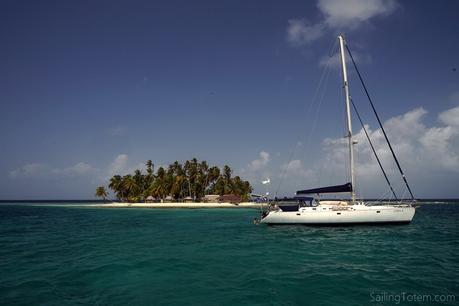
Guna Yala, Kuna Yala, San Blas: an evolution of names for the archipelago that stretches from Panama’s border at Colombia very nearly to the canal zone. Officially “Guna” (the better linguistic match than Kuna) since 2011, the region’s active effort to preserve indigenous culture and traditions creates a draw for many visitors. Here’s what I think is important to know for cruisers in our wake to plan their visit.
Orientation
There is a meaningful divide between “Western” and “Eastern” regions that is worth considering in planning. The personality split begins where boats coming from the canal zone would bend SE if continuing towards Colombia.
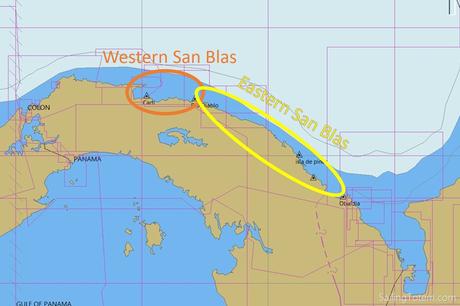
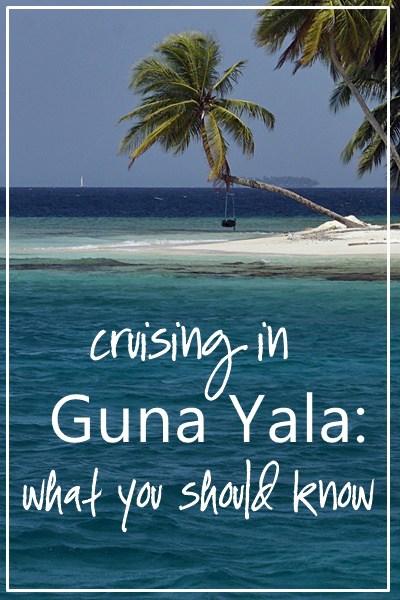
Western communities were a mix of those which followed traditional practices and those which had abandoned it. Basic provisioning (fruit, vegetables, meat, staples) is available, including some dugouts that venture to sell to cruising boats, nearly all cruising boats of which seem to remain in this area.
By contrast, the eastern San Blas is more sparsely populated by Guna and cruisers (we saw only one other cruising boat). Boats carrying cargo arrive from Colombia; as a dejected couple of travelers told us in the eastern port of Obaldia, there’s no road out. You can fly, or you can join a backpacker boat, either at some expense.
Here the water was murkier; this may have been seasonal, but we were there in the dry season when you’d least expect the effect of river runoff. Peak trade winds chopped the water, and together these factors made eyeball navigation difficult. Between water quality and presumed crocodile hazard, swimming was off the menu.
Rules to respect
Visitors are welcomed, but this is Guna land – Guna rules – and between our guest status and indigenous people’s willful choice to separate from modern norms, important to respect. Here’s a snapshot reference for to what the Guna feel are important for visitors to know and avoid: there’s more in the Bauhaus guide.
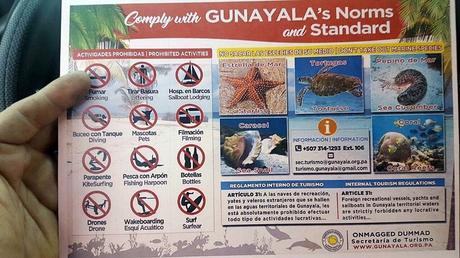
Guna Yala regulations, as sourced from the Kuna Yala Cruisers Facebook group
I had to restrain my usual snap-happy self, as many Guna are reluctant to be photographed. Always ask first: “¿puedo tomar foto?” to know if it’s OK. In some (so picturesque!) communities, there’s no photography allowed at all. I wish I could paint the pictures in my head. And Guna women, in mola blouses, red and yellow head scarf, gold septum rings and necklaces, and bands of beading on their legs and arms… they are stunning and tempting subjects. But – no, unless permission is clearly given.
Ask permission
Besides asking permission for photos: you’re effectively asking permission to anchor, and expected to pay for the privilege. Be a good guest. If you are anchored off an island with a community and aren’t approached by anyone, go ashore and ask for the saila (village leader) to pay up. It’s the right thing to do! The morning after we arrived, a poor Guna became quite irate with us because he thought we were trying to skip out on paying (we were getting ready to depart). When we finally found the receipt we’d been given the night before to show him, he was mollified and paddled off, but the reaction made me think – he’d been taken advantage of before.
Anchoring fees are pretty consistent in eastern Guna Yala. We paid $10 at almost every stop. In the west it was a little different; sometimes we were asked for an anchoring fee (even at uninhabited islands, if they were part of the purview of a nearby community), sometimes it was a cost-per-person ($2) for going on the beach. In either case it was good for a month. If you’re zipping through, they can add up!
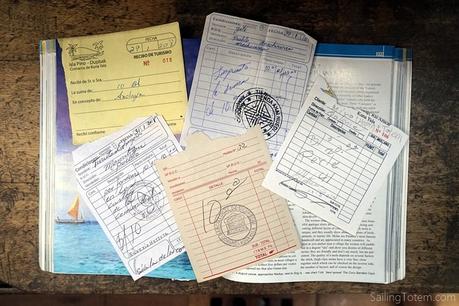
Guna Yala anchoring receipts, on top of Bauhaus’ book
Arrive with cash
US dollars are the currency used in Guna Yala. There are no ATMs, there are no credit cards accepted (there are no roads, or power grid, so…). One family arrived recently and had to borrow money from other boats in order to complete clearance formalities! Kind of shocking planning… granted, it’s unusual.
Bring small bills. If you’ve negotiated a couple of lobster for $10 but only have a $20, there’s probably no change; you’ll be buying more lobster or having none. Small tiendas on Guna islands might make change, but not the dugout on your hip.
Is there trading? No. Well, not really. I wondered, before we got there. But this is not so much a “remote” place as one which has chosen to set itself apart… there is access to Stuff, if people want, and that requires cash. So the bartering that was central to some other corners of the world where we have cruised where Stuff is enough, here it was all about cold hard cash. That said, when I came up short on a mola I wanted to buy, the woman selling it was willing to take a handful of instant coffee packets in lieu of about $10 difference I was trying to make up!
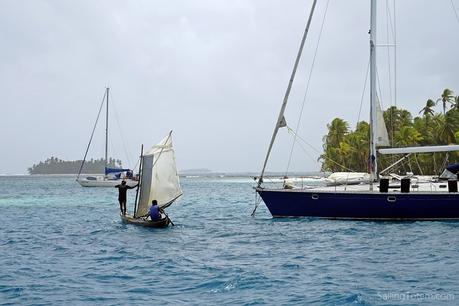
Sailing dugouts are the primary mode of transport, east and western Guna Yala
Provision up
General guidance for Guna Yala is to bring whatever you need, and don’t count on buying anything. That’s a little extreme, as there were small shops on occasional communities. It is limited, so good to plan ahead as have a modicum of flexibility. We actually ran out of toilet paper: PROVISIONING FAIL! Times when it’s good to have friends nearby that will sling you a package of TP!
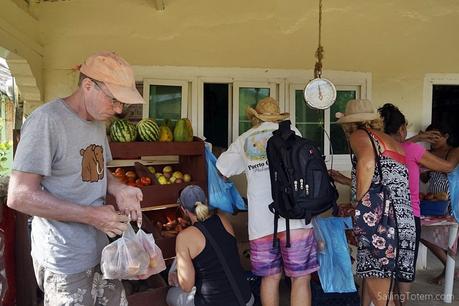
Veggie stand at a shop on Nargana with a posse of cruisers: pretty typical! SV Aseka and Utopia
In the eastern San Blas. where we were offered coconuts, plantains, locally grown fruit or small fish from passing dugouts. On more populated islands there are probably stores; we were only in little islands, and the one store I saw had little more than rice, dried beans, boxed cereal (?), and canned meat.

In the west, boats visit outer reef anchorages specifically to sell produce and meat to cruisers
Honestly, even with the TP fiasco, we’d have been fine. It was available at small shops in Guna communities, along with a surprising variety of other goods. We’re used to adapting our diet to fit what’s available locally, and it wouldn’t have been much adapting to make it work with what we were able to source in San Blas.
Watch for crocs!
Crocodiles are a very real problem in San Blas – this coastline is theirs, not ours, and they do foray out. Risk exists not just in the murky waters near shore but the gin-clear reefs offshore. Yes, both. Even on the islands away from mangroves and murk, dogs have been taken off beaches and a snorkeling cruiser was attacked (and survived, but not without a helicopter ride to the hospital in Panama City) in 2017. What can you do? Find out through the cruiser’s coconut telegraph (radio nets, Facebook groups, deck-to-dinghy chats) if and where they’ve been spotted, and consider whether you want to get in the water or not. I wouldn’t forgo swimming, I’d just swim with some information.
I didn’t realize
We’d be so disconnected! Cruisers reported “there’s internet here,” and I just believed it. Well, there is, in some parts of western Guna Yala. We found none in the much larger eastern region. The Iridium GO kept us connected, but at a text-only basis. (You can post pictures to a Facebook profile from the GO, but not to a Facebook page…to my chagrin).
Plastic garbage. There is an appalling amount of garbage, some floating in the water, much of it just drifted up on the beach. It’s far, far too much to do anything about. At least those were the only crocs we saw while in Guna Yala.
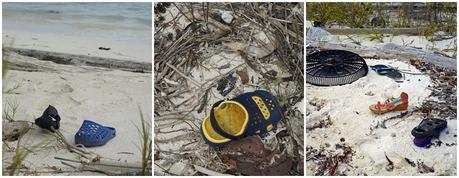
Crocs of San Blas
Liveaboard community. Gringos have been living aboard (is it really cruising when the western bay where all these boats hang out is only 35 miles wide?) in San Blas for years. There’s a nice collection of some really helpful folks. There’s the inevitable dose of jaded old-timers who seem to have forgotten they are guests and have a skewed view of their “rights.” Whatever. On balance they the driving reason behind this curious distinction between the western and eastern portions of San Blas.
Instant coffee is a hit. Who knew! I’ve been working through a hoard of individual serving packets which are very convenient on night watch. When someone stops by, unless they’re a flyby offer to sell fish, visitors are invited into the cockpit to sit in the shade and have a drink. We don’t have sodas on board so it was water or coffee and… well I served a lot of coffee! It would be a great gift item to make nice with the local sahila or a Guna family that you meet.
Next time
If (when? I hope when!) we revisit, I’d plan differently. Mainly, we’d extend our stay, and skew heavily towards eastern Guna Yala. We found the frontier nature of it far more interesting. There was minimal tourism; people had more time; they weren’t only interested in us as potential transactions. Exactly the kind of place we love to sink into and understand better.
Second, I’d extend the stays in individual anchorages, instead of moving on after a night our two (an unfortunate pace driven by necessity at the time). This is a fascinating region, and when you skip through as quickly as we did – you don’t have the opportunity to really connect and understand much of what makes it special. It takes time we couldn’t give to gain that permission and trust.

Fishermen cooperate for the morning catch
Helpful resources
The Panama Cruising Guide by Eric Bauhaus is an invaluable reference; there’s really not a substitute. The chapter on San Blas opens with an illuminating discussion of Guna history and culture, along with guidance for how to be sensitive to it as a visitor. For details about the islands, it’s the best, and the author has surveyed the region extensively: his charts are the best reference for a coastline which was mostly “unsurveyed” or insufficient for use in our (new!) Navionics charts. They aren’t infallible, but what chart is? We don’t always pick up cruising guides, but I cannot imagine cruising Guna Yala without this one (thank you MM!).
Bauhaus’ chartlets, digitized. Some helpful person turned chartlets in the Bauhaus guide into KAP files you can overlay on your charts (we used OpenCPN for this). Particularly in the eastern territory, murky water hampers visual piloting. Know that Google Earth / satellite imagery isn’t high enough resolution to be useful in many areas, particularly the east. Readily passed between boats on memory sticks, they are invaluable. They are also the intellectual property of Eric Bauhaus! If you acquire and use them, figure out how to pay him. I emailed him, but he never replied… just buy the book, which you can pick up in Linton or Shelter Bay Marina if you didn’t plan ahead.
San Blas Cruisers on Facebook This helpful group is administered by long-term San Blas cruiser/liveaboards who strive to keep information flowing and on point.
Radio. San Blas cruisers have a morning mobile maritime net. It’s a long time since we’ve been regulars on the SSB, but this was very useful for sharing information in an area too spread out for VHF. The 8 meg frequency is posted in the Facebook group. On VHF, 72 is standard hailing for cruisers here.
Totem and crew are in Puerto Vallarta, Mexico… playing catch up on notes & info to share with the community and cruisers in our wake. In case you missed the memo, just because we completed a circumnavigation doesn’t mean we’re done cruising! More adventures ahead.

